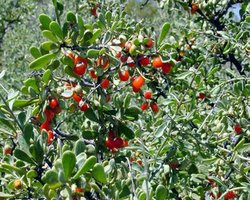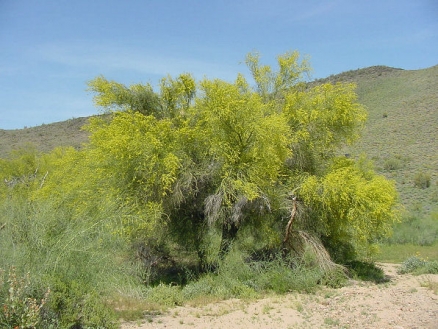Seed dispersal of desert plants
Contents
Introduction Seeds generally need to be transported some distance from the parent plant in order to find a suitable site for establishment. (Seed dispersal of desert plants)
Dispersal mechanisms in the desert
Dispersal by the wind
Some plants have wind-dispersed seeds, which are occasionally blown many miles from their origins. This means of dispersal is common among pioneer plants (plants that are adapted to colonizing disturbed habitats). Because of their superior ability to invade newly-disturbed ground, pioneer plants comprise many of our agricultural and garden weeds. Moreover, most annual crops are domesticated pioneer plants. That’s why we need to plow (disturb) fields in order to grow them.
Dispersal by animals
 Animal-dispersed fruits of boxthorn, Lycium exsertum. (Photo by Mark Dimmitt, Arizona-Sonoran Desert Museum)
Animal-dispersed fruits of boxthorn, Lycium exsertum. (Photo by Mark Dimmitt, Arizona-Sonoran Desert Museum) Many plants use animals to disperse their seeds in another complex coevolutionary process. Small, brightly-colored fruits such as hackberry and boxthorn are offered as food for birds that swallow them whole. Other fruits such as those of hedgehog cacti are large and birds feed on them repeatedly. Some bird fruits are sticky, such as mistletoe berries; a few stick to the bird’s bill until wiped off on a branch while others are successfully swallowed. The seeds of bird fruits are typically small and hard; they pass through birds’ guts undamaged and may be deposited many miles from the parent plant.
Mammal-dispersed fruits tend to be larger, aromatic, not colorful (most non-primate mammals have poor color vision), and usually have larger seeds than bird fruits. The animal often transports the fruits a short distance (compared to the flying distances of many birds) to a safer place before eating the pulp and dropping at least some of the seeds. The seeds of coyote gourds (Cucurbita spp.) may be dispersed in this manner. Coyotes swallow the whole fruits of palm trees; they digest the thin pulp and excrete the hard seeds intact. Since seeds contain energy stores to nourish the germinating embryo, seeds themselves are also nutritious food for mammals and birds. Some plants offer their seeds without juicy pulp to attract mammals. Pocket mice and antelope squirrels gather the abundant seeds of foothill palo verdes and bury them as food caches for the dry season. The animals don’t eat all that they bury, so some seeds remain in the ground and germinate when the rains come. (Birds that specialize in eating seeds, as opposed to fruits containing seeds, crush and digest the seeds and therefore do not disperse viable propagules.)
Dispersal by water
Even in the desert some seeds are water-dispersed. Blue palo verde (Cercidium floridum) grows mostly along washes. Flash floods disperse the very hard, waterproof seeds downstream, scarifying (abrading the surface of) them in the process. In the absence of scarification these seeds must weather in the ground for a few years before the seed coats become permeable and permit germination.
Timing of seed maturation
The timing of seed maturation is crucial for many plants. The less time seeds are present before they sprout, the greater is their chance of survival. For example, the tropically derived plants in the Sonoran Desert germinate with the summer rains. These species usually flower in spring and their fruits ripen shortly before the arrival of the summer rainy season. Palo verde and saguaro are examples. Other plants produce large quantities of seeds and rely on camouflage or burial in the soil to conceal some of them from hungry animals. Brittlebush, for example, flowers and seeds in spring, but the seeds germinate with fall rains. Annuals do the same.
Further Reading
- Plant Ecology of the Sonoran Desert Region, Arizona-Sonora Desert Museum.
- Fruits and Seeds, Botany Online.
- Phillips, S.J. and P.W. Comus (eds.) 2000. A Natural History of the Sonoran Desert. Arizona-Sonora Desert Museum Press, Tucson, and University of California Press, Berkeley.
| Disclaimer: This article is taken wholly from, or contains information that was originally published by, the Arizona-Sonora Desert Museum. Topic editors and authors for the Encyclopedia of Earth may have edited its content or added new information. The use of information from the Arizona-Sonora Desert Museum should not be construed as support for or endorsement by that organization for any new information added by EoE personnel, or for any editing of the original content. |
